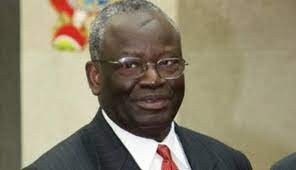The Second Niger Bridge, initially billed for completion last month, but now rescheduled for October, this year. Chief of Staff (CoS) to the President, Prof. Ibrahim Gambari, who inspected the project yesterday, expressed satisfaction with the work done so far and was optimistic that, with the pace of work, the project would be delivered by the third quarter of the year, as promised by the contractors.
He commended the contractors for not just the speed of work, but also their safety and environmental concerns in the execution of the project. According to him, the project has cost the Federal Government about N400 billion, in addition to the N10 billion committed into it by the administration of former President Goodluck Jonathan.

Gambari said contrary to insinuations, the project is being funded 100 per cent by the Nigerian government.
A director in the Federal Ministry of Works and Housing, who is representative engineer for the Second Niger Bridge, Adeyemo Ajani, had earlier told the CoS and his entourage that the 1.6km bridge across the River Niger, linking the South East with the South South and South West, which started in September 2018, “has reached 83 per cent completion” and would now be ready for use from October this year.
Gambari, who is inspecting major Federal Government legacy projects across the country, was accompanied by the Minister of Works and Housing, Mr. Babatunde Fashola (SAN); his Labour and Employment counterpart, Dr. Chris Ngige; Managing Director of the Nigeria Sovereign Investment Authority (NSIA), Mr. Uche Orji and other top government functionaries.
Ajani and the Managing Director of Julius Berger Plc, Mr. Lars Richter, conducted them round the proposed access roads at the Delta State end of the project and the Owerri interchange, nearing completion.
Fashola disclosed that there would be power disruption around the Owerri interchange for two weeks to enable the Transmission Company of Nigeria (TCN) relocate and realign the high-tension transmission lines to pave way for the completion of the ring roads connecting the bridge from all routes.
He also disclosed that with the completion of concrete work on the bridge, making it possible for a walk from the beginning to the end, the minor alignments on the structure would be finished before the end of next month.
The minister stated that although the Federal Executive Council (FEC) had approved tolling of 12 highways in the country, the Federal Government had yet to decide on that of the Second Niger Bridge head, even as toll gates were being constructed at the site, adding that his priority was to complete the road before delving into tolling.
Richter had earlier told the entourage that due to the difficult terrain, the company deployed a special technology to stabilise the ground for the construction work to progress in earnest and provided environmental safety for all the communities around the area.
Ajani said: “The Bridge itself is 93 per cent completed, which means that all the sub-structure works have been completed and the super structure is ongoing. We have just 10 metres to link the entire bridge of 1.6km at the moment. We have commenced the finishing works, such as parapet and other auxiliary works on the bridge.
“All things being equal, the bridge would have been completed and ready for use by October this year. On completion, because it is not a stand-alone bridge, the ministry is thinking of doing a temporary connection via an access road around Oko in Delta, immediately after the old toll gate, to put it to immediate use, linking not just Onitsha, but also Owerri.”

